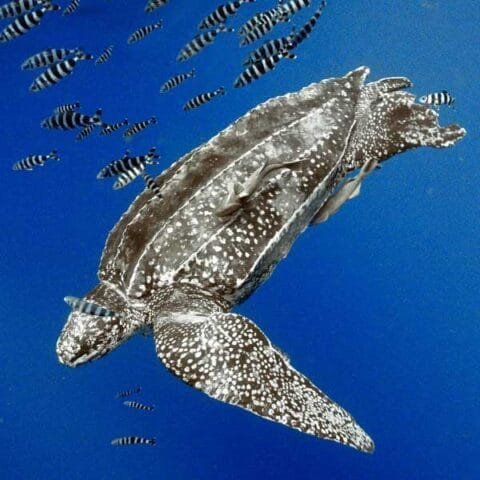
Leatherback turtles are fascinating creatures that roam the world’s oceans. Unfortunately, they’re also under threat due to human activities. Understanding more about these incredible animals helps us appreciate their place in the ecosystem and motivates us to protect them. So, let’s dive into some cool facts about leatherback turtles that you probably didn’t know!
1. They’re the Largest Sea Turtles
Leatherback turtles can grow up to an astonishing length of about 7 feet, and they can weigh between 500 to 2,000 pounds. That’s roughly the size of a small car! Unlike other turtles, which have hard, bony shells, leatherbacks have a unique, flexible shell made of a tough, leathery material. This characteristic allows them to dive deep into the ocean, reaching depths of over 4,000 feet in search of their favorite food—jellyfish.
Imagine a creature so large gliding through the water without a care in the world. That’s the leatherback for you! Their ability to dive so deep and remain submerged for long periods makes them fascinating, but it also creates challenges when it comes to their survival.
2. They’re Great Divers
Speaking of diving, leatherback turtles are champions when it comes to exploring the depths of the ocean. They can dive over 4,000 feet deep and hold their breath for up to 85 minutes! That’s like an Olympic swimmer going for the gold in a free dive.
When they’re diving, leatherbacks rely on their large, muscular bodies and streamlined shape to propel themselves through the water. They hunt jellyfish and other soft-bodied creatures, making them crucial players in maintaining the balance of ocean ecosystems. However, their deep diving habits make them vulnerable to human impacts like fishing gear and pollution.
3. They Have a Unique Diet
You might be surprised to learn that leatherback turtles primarily feast on jellyfish. Yes, those wobbly, squishy sea creatures! This makes them incredibly important for regulating jellyfish populations. A healthy leatherback can consume up to 73,000 jellyfish in a year.
However, their preference for jellyfish puts them at risk. Many turtles mistake plastic bags for jellyfish, and when they consume these, it can lead to serious health issues or even death. This is just one more reason we should minimize plastic waste and protect our oceans.
4. They Can Regulate Their Body Temperature
Leatherback turtles have a unique ability that sets them apart from other turtles: they can maintain their body temperature even in colder waters. This remarkable adaptation allows them to venture into chilly regions, making them the only turtle species that can tolerate these conditions.
So, how do they do this? Leatherbacks possess a thick layer of blubber under their skin, which insulates them against the cold. This adaptation is crucial for their survival, allowing them to access diverse feeding grounds. Imagine being able to enjoy an ice-cold drink on a hot day while staying warm—now that’s a superpower!
5. They’re Migratory Travelers
Leatherbacks are known for their epic migrations. These turtles travel thousands of miles between nesting sites and feeding grounds. Some leatherbacks journey from as far north as Alaska to tropical waters near the equator. That’s a round trip of over 10,000 miles!
During these migrations, they often navigate using the earth’s magnetic fields and the position of the sun. It’s like they have built-in GPS systems! Their long journeys are critical for their reproduction and access to food, but they also expose them to various dangers, including fishing nets and boats.
6. They Play a Role in Marine Ecosystems
Leatherback turtles aren’t just fascinating creatures; they also play a vital role in their ecosystems. By consuming jellyfish, they help control populations that could otherwise explode, leading to imbalances in marine life.
Additionally, their nesting activities contribute to beach and dune health. When female leatherbacks come ashore to lay eggs, they help aerate the sand and enrich it with nutrients through their nesting practices. This simple action fosters a healthier environment for other wildlife. It’s a beautiful cycle of life at work!
7. They’re Facing Serious Threats
Unfortunately, leatherback turtles are classified as vulnerable and face numerous threats. Habitat loss, climate change, bycatch in commercial fishing, and pollution are some of the most significant challenges they encounter.
Climate change affects their nesting sites, leading to increased temperatures that can skew sex ratios in hatchlings—warmer nests tend to produce more females, which could threaten future populations. Awareness and conservation efforts are crucial to protect these magnificent turtles.
8. They Have a Unique Nesting Behavior
Nestled within the sand, leatherback turtle eggs are a crucial part of the species’ life cycle. Female leatherbacks usually return to the same beaches where they hatched to lay their eggs. They can lay up to 100 eggs in a single nesting season!
After laying their eggs, females cover the nest with sand and return to the sea, leaving the eggs to develop and hatch on their own. These hatchlings face numerous challenges as they make their way to the ocean, often struggling against predators and harsh weather. It’s a remarkable journey that showcases the resilience of these little creatures.
9. They’re Ancient Creatures
Leatherback turtles have been around for millions of years—long before dinosaurs roamed the Earth. They’ve adapted beautifully to their environments, and their lineage dates back over 100 million years!
These ancient mariners have survived through numerous changes in the Earth’s climate and ecosystems. Their resilience is a testament to their adaptability, but it also highlights the importance of understanding and protecting their habitats today.
10. Conservation Efforts Are Underway
Many organizations worldwide are working tirelessly to protect leatherback turtles and their habitats. Conservation efforts include beach clean-up initiatives, protecting nesting sites, and working with fishermen to reduce bycatch.
You might even see local communities getting involved in “turtle walks,” where volunteers help guide hatchlings to the ocean safely. By spreading awareness and creating programs that support these magnificent turtles, we can help ensure their survival for future generations.
In summary, leatherback turtles are truly remarkable creatures, showcasing the wonders of the natural world. From their incredible size and deep-diving abilities to their unique diets and long migrations, there’s so much to admire. As they face various challenges, our role in their conservation becomes increasingly important. By staying informed and supporting protective measures, we can all play a part in the survival of these magnificent beings.

